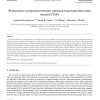Free Online Productivity Tools
i2Speak
i2Symbol
i2OCR
iTex2Img
iWeb2Print
iWeb2Shot
i2Type
iPdf2Split
iPdf2Merge
i2Bopomofo
i2Arabic
i2Style
i2Image
i2PDF
iLatex2Rtf
Sci2ools
DSP
2007
2007
Performance comparison between statistical-based and direct data domain STAPs
In the situation that a radar platform is moving very fast, the number of training data used in space-time adaptive processing (STAP) is a major concern. Less number of training data is preferred in this situation. In this paper, four versions of statistical-based and direct data domain STAPs are discussed and compared their performance when the number of training data is varied. The four statistical-based methods are the full-rank statistical method, the relative importance of the eigenbeam (RIE) method, the principle component generalized sidelobe canceller (GSC) method, and the cross-spectral GSC method. We will compare the performance of these four methods with that of the direct data domain least squares (D3LS) approach, which utilizes only one snapshot of data in its processing. The channel mismatch will be also introduced to all methods to evaluate their performance. It is found that to make the statistical-based methods work; we need to know the rank of the interference covari...
| Added | 13 Dec 2010 |
| Updated | 13 Dec 2010 |
| Type | Journal |
| Year | 2007 |
| Where | DSP |
| Authors | Santana Burintramart, Tapan K. Sarkar, Yu Zhang, Michael C. Wicks |
Comments (0)

